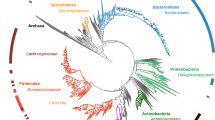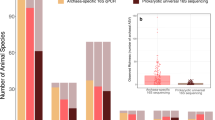Abstract
Snakes are capable of surviving long periods without food. In this study we characterized the microbiota of a Timber Rattlesnake (Crotalus horridus), devoid of digesta, living in the wild. Pyrosequencing-based metagenomics were used to analyze phylogenetic and metabolic profiles with the aid of the MG-RAST server. Pyrosequencing of samples taken from the stomach, small intestine and colon yielded 691696, 957756 and 700419 high quality sequence reads. Taxonomic analysis of metagenomic reads indicated Eukarya was the most predominant domain, followed by bacteria and then viruses, for all three tissues. The most predominant phylum in the domain Bacteria was Proteobacteria for the tissues examined. Functional classifications by the subsystem database showed cluster-based subsystems were most predominant (10–15 %). Almost equally predominant (10–13 %) was carbohydrate metabolism. To identify bacteria in the colon at a finer taxonomic resolution, a 16S rRNA gene clone library was created. Proteobacteria was again found to be the most predominant phylum. The present study provides a baseline for understanding the microbial ecology of snakes living in the wild.



Similar content being viewed by others
References
Clark RW (2002) Diet of the Timber Rattlesnake. J Herpetol 36:494–499
Clark RW (2006) Fixed videography to study predation behavior of an ambush foraging snake, Crotalus horridus. Copeia 2006:181–187
Reinert HK, MacGregor GA, Esch M, Bushar LM, Zappalorti RT (2011) Foraging ecology of timber rattlesnakes, Crotalus horridus. Copeia 2011:430–442
Wittenberg RD (2012) Foraging ecology of the timber rattlesnake (Crotalus horridus) in a fragmented agricultural landscape. Herpetol Conserv Biol 7:449–461
Beaupre SJ, Zaidan F 3rd (2012) Digestive performance in the timber rattlesnake (Crotalus horridus) with reference to temperature dependence and bioenergetics cost of growth. J Herpetol 46:637–642
Dethlefsen L, Eckburg PB, Bik EM, Relman DA (2006) Assembly of the human intestinal microbiota. Trends Ecol Evol 21:517–523
Savage DC (1977) Microbial ecology of the gastrointestinal tract. Annu Rev Microbiol 31:107–133
Ley RE, Backhed F, Turnbaugh P, Lozupone CA, Knight RD, Gordon JI (2005) Obesity alters gut microbial ecology. Proc Natl Acad Sci USA 102:11070–11075
Samuel BS, Shaito A, Motoike T, Rey FE, Backhed F, Manchester JK, Hammer RE, Williams SC, Crowley J, Yanagisawa M, Gordon JI (2008) Effects of the gut microbiota on host adiposity are modulated by the short-chain fatty-acid binding G protein-coupled receptor, Gpr41. Proc Natl Acad Sci USA 105:16767–16772
Turnbaugh PJ, Hamady M, Yatsunenko T, Cantarel BL, Duncan A, Ley RE, Sogin ML, Jones WJ, Roe BA, Affourtit JP, Egholm M, Henrissat B, Heath AC, Knight R, Gordon JI (2009) A core gut microbiome in obese and lean twins. Nature 457:480–487
Turnbaugh PJ, Ley RE, Mahowald MA, Magrini V, Mardis ER, Gordon JI (2006) An obesity-associated gut microbiome with increased capacity for energy harvest. Nature 444:1027–1031
Backhed F, Ding H, Wang T, Hooper LV, Koh GY, Nagy A, Semenkovich CF, Gordon JI (2004) The gut microbiota as an environmental factor that regulates fat storage. Proc Natl Acad Sci USA 101:15718–15723
Crawford PA, Crowley JR, Sambandam N, Muegge BD, Costello EK, Hamady M, Knight R, Gordon JI (2009) Regulation of myocardial ketone body metabolism by the gut microbiota during nutrient deprivation. Proc Natl Acad Sci USA 106:11276–11281
Klein S, Cohn MD, Alpers DH (1998) Alimentary tract in nutrition. In: Shils ME, Olson JA, Shike M, Ross AC (eds) Modern nutrition in health and disease. Williams & Wilkins, Baltimore, p 1140
Nossa CW, Oberdorf WE, Yang L, Aas JA, Paster BJ, Desantis TZ, Brodie EL, Malamud D, Poles MA, Pei Z (2010) Design of 16S rRNA gene primers for 454 pyrosequencing of the human foregut microbiome. World J Gastroenterol 16:4135–4144
Ruemmele FM, Bier D, Marteau P, Rechkemmer G, Bourdet-Sicard R, Walker WA, Goulet O (2009) Clinical evidence for immunomodulatory effects of probiotic bacteria. J Pediatr Gastroenterol Nutr 48:126–141
Serban DE (2011) The gut microbiota in the metagenomics era: sometimes a friend, sometimes a foe. Roum Arch Microbiol Immunol 70:134–140
Beaupre SJ (1996) Field metabolic rate, water flux, and energy budgets of mottled rock rattlesnakes, Crotalus lepidus, from populations. Copeia 1996:319–329
Beaupre SJ (2002) Modeling time-energy allocation in vipers: individual responses to environmental variation and implications for populations. In: Schuett GW, Höggren MR, Douglas ME, Greene HW (eds) The biology of vipers. Eagle Mountain Publishing, LC, Eagle Mountain, pp 463–480
Hill JG III, Hanning I, Beaupre SJ, Ricke SC, Slavik MM (2008) Denaturing gradient gel electrophoresis for the determination of bacterial species diversity in the gastrointestinal tracts of two crotaline snakes. Herpetol Rev 39:433–438
Costello EK, Gordon JI, Secor SM, Knight R (2010) Postprandial remodeling of the gut microbiota in Burmese pythons. ISME J 4:1375–1385
Weisburg WG, Barns SM, Pelletier DA, Lane DJ (1991) 16S ribosomal DNA amplification for phylogenetic study. J Bacteriol 173:697–703
Schloss PD, Westcott SL, Ryabin T, Hall JR, Hartmann M, Hollister EB, Lesniewski RA, Oakley BB, Parks DH, Robinson CJ, Sahl JW, Stres B, Thallinger GG, Van Horn DJ, Weber CF (2009) Introducing mothur: open-source, platform-independent, community-supported software for describing and comparing microbial communities. Appl Environ Microbiol 75:7537–7541
Tamura K, Peterson D, Peterson N, Stecher G, Nei M, Kumar S (2011) MEGA5: molecular evolutionary genetics analysis using maximum likelihood, evolutionary distance, and maximum parsimony methods. Mol Biol Evol 28:2731–2739
Meyer F, Paarmann D, D’souza M, Olson R, Glass EM, Kubal M, Paczian T, Rodriguez A, Stevens R, Wilke A, Wilkening J, Edwards RA (2008) The metagenomics RAST server–a public resource for the automatic phylogenetic and functional analysis of metagenomes. BMC Bioinformatics 9:386
Rawls JF, Mahowald A, Ley E, Gordon JI (2006) Reciprocal gut microbiota transplants from zebrafish and mice to germ-free recipients reveal host habitat selection. Cell 127:423–433
Roseslers G, Mittge EK, Stephens WZ, Parichy DM, Cavanaugh CM, Guillemin K, Rawls JF (2011) Evidence for a core gut microbiota in zebrafish. ISME J 5:1995–1996
García-Amado MA, Godoy-Vitorino F, Piceno YM, Tom LM, Andersen GL, Herrera EA, Domínguez-Bello MG (2012) Bacterial diversity in the cecum of the world’s largest living rodent (Hydrochoerus hydrochaeris). Microb Ecol 63:719–725
Xenoulis PG, Gray PL, Brightsmith D, Palculict B, Hoppes S, Steiner JM, Tizard I, Suchodolski JS (2010) Molecular characterization of the cloacal microbiota of wild and captive parrots. Vet Microbiol 146:320–325
Lentle RG, Dey D, Hulls C, Mellor DJ, Moughan PJ, Stafford KJ, Nicholas K (2006) A quantitative study of the morphological development and bacterial colonisation of the gut of the tammar wallaby Macropus eugenii eugenii and brushtail possum Trichosurus vulpecula during in-pouch development. J Comp Physiol B 176:763–774
Whitaker JO Jr, Hamilton WJ Jr (1998) Mammals of the eastern United States, 3rd edn. Comstock Publishing Associates, Cornell University Press, Ithaca, p 583
Glad T, Kristiansen VF, Nielsen KM, Brusetti L, Wright AD, Sundset MA (2010) Ecological characterisation of the colonic microbiota in arctic and sub-arctic seals. Microbiol Ecol 60:320–330
Ritchie LE, Steiner JM, Suchodolski JS (2008) Assessment of microbial diversity along the feline intestinal tract using 16S rRNA gene analysis. FEMS Microbiol Ecol 66:590–598
Suchodolski JS, Camacho J, Steiner JM (2008) Analysis of bacterial diversity in the canine duodenum, jejunum, ileum, and colon by comparative 16S rRNA gene analysis. FEMS Microbiol Ecol 66:567–578
Leser TD, Amenuvor JZ, Jensen TK, Lindecrona RH, Boye M, Møller K (2002) Culture-independent analysis of gut bacteria: the pig gastrointestinal tract microbiota revisited. Appl Environ Microbiol 68:673–690
Cohen ML, Potter M, Pollard R (1980) Turtle-associated salmonellosis in the United States, effect of public health action, 1970 to 1976. JAMA 243:1247–1249
Mermin J, Hoar B, Angulo FJ (1997) Iguanas and Salmonella marina infection in children: a reflection of the increasing incidence of reptile-associated salmonellosis in the United States. Pediatrics 99:399–402
Waterman SH, Juarez G, Carr SJ, Kilman L (1990) Salmonella arizonae infections in Latinos associated with rattlesnake folk medicine. Am J Public Health 80:286–289
Schroter M, Roggentin P, Hofmann J, Speicher A, Laufs R, Mack D (2004) Pet snakes as a reservoir for Salmonella enterica subsp. diarizonae (Serogroup IIIb): a prospective study. Appl Environ Microbiol 70:613–615
Grupka LM, Ramsay EC, Bemis DA (2006) Salmonella surveillance in a collection of rattlesnakes (Crotalus spp.). J Zoo Wildl Med 37:306–312
CDC (2011) National Salmonella surveillance overview. US Department of Health and Human Services, CDC, Atlanta
Ramsay EC, Daniel GB, Tryon BW, Merryman JI, Morris PJ, Bemis DA (2002) Osteomyelitis associated with Salmonella enterica SS arizonae in a colony of ridgenose rattlesnakes (Crotalus willardi). J Zoo Wildl Med 33:301–310
Acknowledgments
We would like to thank Bryan Albrecht, Zina Haywood, Stephanie Sklba, Bernard O’Connell, Donald Zakutansky and Jennifer Charpentier for their enthusiastic support of this research. This project was supported by funding provided by Gateway Technical College and by the Gateway Foundation, through its Inspiration Grant Program. Access to the Timber Rattlesnake specimen was authorized through a permit from the Minnesota Department of Natural Resources to PAC.
Author information
Authors and Affiliations
Corresponding author
Electronic supplementary material
Below is the link to the electronic supplementary material.
Rights and permissions
About this article
Cite this article
McLaughlin, R.W., Cochran, P.A. & Dowd, S.E. Metagenomic analysis of the gut microbiota of the Timber Rattlesnake, Crotalus horridus . Mol Biol Rep 42, 1187–1195 (2015). https://doi.org/10.1007/s11033-015-3854-1
Received:
Accepted:
Published:
Issue Date:
DOI: https://doi.org/10.1007/s11033-015-3854-1




